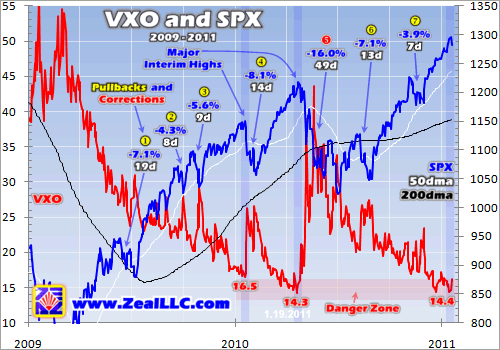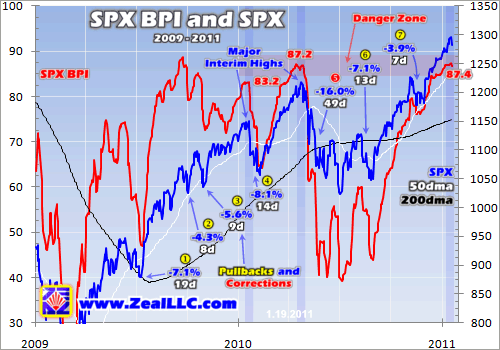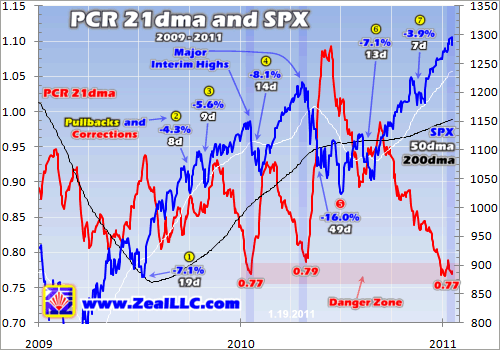|
|
|||||||
|
|
|
|
|
|
|
|
|
|
SPX Correction Looms Adam Hamilton January 21, 2011 2823 Words
The US stock markets have enjoyed an awesome run since late August, with the flagship S&P 500 stock index (SPX) up 23.7%. Traders have earned huge profits in sectors that leverage general-stock-market gains, including commodities stocks. But as usual after any long and uninterrupted rally, complacency reigns supreme today. Such sentiment is a prime breeding ground for spawning corrections.
Nearly all short-term price movements are driven by the collective emotions of traders. When they feel good, they buy stocks. And rising prices eventually lead to greed. When they feel bad, they sell stocks. And falling prices ultimately spark fear. These two emotions are perpetually warring, swinging back and forth like a great pendulum. Greed dominates when prices are up, then fear flares when they are down.
Complacency is a close relative to greed. It is “a feeling of quiet pleasure or security, often while unaware of some potential danger”. Like greed, complacency grows when prices are high. The conditions that generate it are long, uninterrupted rallies leading to big gains. After the stock markets rally gradually for months without retreating, the majority of traders start assuming the risk of a selloff has vanished.
But this is always a foolish assumption, as all markets flow and ebb. Bull markets advance forward two steps before retreating one step in their periodic selloffs. Far from being bad, these retreats are extremely beneficial for traders. They rebalance sentiment, bleeding off excessive greed and complacency. This extends the life of the bull market, as it will burn out prematurely if greed sucks in too many traders too quickly. And they drag prices back down, creating the best buying opportunities seen in an ongoing bull.
The more years you spend trading stocks as a student of the markets, the easier it becomes to recognize the excessive complacency that leads to stock-market retreats. It manifests universally in the things the financial media reports, the way analysts and traders view the markets, and how smug everyone becomes about the current rally continuing indefinitely. As an example, this week on CNBC I heard a professional money manager forecast “a 24% gain in the S&P 500 during the next 100 trading days”!
While the subjective read on the collective emotions dominating the markets is incredibly valuable, it takes many years to develop the experience necessary for this skill. Thankfully there are hard objective indicators that betray extreme complacency. When they get to certain levels, the odds of an imminent retreat balloon dramatically. All traders can watch these indicators as warning signs preceding retreats.
I will explore several of my favorites in this essay, the VXO implied-volatility index, the SPX bullish-percent index, and the put/call ratio. My charts this week superimpose the last couple years of S&P 500 action (its current cyclical bull) over these key sentiment indicators. As I suspect you’ll agree after digesting this analysis, given these indicators’ positions today probabilities heavily favor an SPX retreat.
I use the word “retreat” to encompass both pullbacks and corrections, which have specific definitions in the stock markets. Pullbacks are retreats in the major stock indexes running less than 10%, while corrections are larger retreats weighing in at more than 10%. Provocatively given the extreme states of these sentiment indicators today, it is increasingly likely a full-blown SPX correction looms.
Let’s start with the premier sentiment gauge, the VXO. It was the original old-school VIX before that index was heavily modified in September 2003. Technically the VXO measures implied volatility in at-the-money options, expiring 30 calendar days out, for the elite S&P 100 stock index. This index represents the top 20% of the S&P 500 companies, the biggest and most-liquid stocks trading in the US. During any material stock-market selloff, these are the companies sold first, fastest, and most. They can readily absorb huge volumes, letting traders exit quickly with minimal adverse price impact.
Despite the new VIX’s popularity with the financial media, the original-formula one (now VXO) remains a much purer measure of sentiment. Today’s VIX was diluted by adding the lower 80% of SPX stocks, which are much less liquid and hence less responsive in major selloffs. It also includes a broader range of short-term options, including out-of-the-money ones that are also less responsive to market moves.
In the VXO, high levels reflect heavy volatility and extreme fear. We saw epic VXO extremes during 2008’s once-in-a-century stock panic. Volatility and fear was off the charts. I used the VXO to call the major SPX bottom early in March 2009 leading into today’s bull. Conversely low VXO levels reflect greed and/or complacency. And as this chart shows, the VXO has recently ground down to some of the lowest levels seen in this entire stock bull since the panic.
A month ago on December 22nd, the VXO slumped to 14.37 on close. And then again last Friday, it fell to 14.36. As the red VXO line shows, these are very low levels relative to the past couple years. The only other times the VXO has even come close to today’s levels were back in April 2010 (14.26) and January 2010 (16.49). And look what happened to the blue SPX line immediately after these reads.
The US stock markets as measured by the flagship S&P 500 saw major interim highs right at those previous VXO lows! After last January’s low VXO reading indicating extreme complacency, the SPX promptly fell 8.1% over the next 14 trading days. While still in pullback territory (less than 10%), this was the biggest retreat seen in this entire cyclical bull to that point. Traders caught unaware got slaughtered.
And then again last April the SPX peaked right when the VXO hit the same levels we’ve seen in recent weeks. Complacency was so out of hand then that the SPX needed a full-blown correction to rebalance sentiment! The stock markets ultimately plunged 16.0% in 49 trading days, their first correction-magnitude decline of today’s cyclical bull. Once again smug traders who didn’t expect such a selloff were crushed.
These periodic selloffs are such a big deal because their impact is leveraged in hot sectors like commodities stocks. Losses in the large commodities stocks during major SPX selloffs often amplify the broader stock markets’ declines by 2 to 1 or more. So a 15% SPX retreat, a garden-variety correction, can easily lead to losses approaching a third in a matter of weeks for big commodities stocks! And smaller more-speculative ones often fare even worse. So gaming these periodic retreats is critical for traders.
If you can read sentiment and anticipate such selloffs before they happen, you can realize the gains on your existing trades near the preceding interim highs. This builds up cash balances which are the perfect way to weather a pullback or correction. After the retreats run their courses, you can then buy back in to your old trades or launch new trades with a lot more bang for your buck (your same capital can buy many more shares).
So seeing the VXO back down in the danger zone from which the biggest pullback and only correction of this entire cyclical bull were born is a huge warning sign. Traders have to understand that no matter how great everyone feels about the markets today, the odds overwhelmingly favor a serious selloff. Complacency is just too extreme, and since the markets abhor extremes they are never sustainable.
The second indicator to consider is the SPX’s Bullish Percent Index. It reveals what percentage of the 500 stocks in this index currently show buy signals in their point-and-figure charts. Point-and-figure charting is an interesting relic from the dark days before the Information Age. Easily done by hand, it didn’t require computers and spreadsheets. It shows rising prices as columns of Xs and falling prices as columns of Os.
These charts are fascinating because they distill out the effects of time. Each point-and-figure column can represent one day or many days, within the same chart. Not showing time in the usual linear fashion offers some unique insights into trends that normal price charts can’t reveal. While this makes point-and-figure charting confusing at first, it is a rigid discipline with well-defined rules. For BPI purposes, any stock’s chart always shows either a point-and-figure buy or sell. There is no ambiguity.
Like most sentiment indicators, BPIs are contrarian. You want to buy stocks when other traders are the most scared, because that is when prices are lowest. And you want to sell when others are the most greedy or complacent, because prices peak then. So a high SPX BPI reveals extensive bullishness, hence greed and complacency, in the stock markets. These are the times to sell and await a retreat.
Just this week the SPX’s bullish-percent index soared to 87.4, meaning 87.4% of the elite 500 stocks in this flagship index were showing point-and-figure buy signals! Note that this is well into the danger zone that marked the major interim highs before the biggest pullback and only correction of this entire cyclical bull. Last January before that big 8.1% pullback, the SPX BPI peaked at 83.2. And in April before that 16.0% correction, it hit 87.2. Today once again the SPX BPI is right at these dangerous levels.
When stocks have been bought for so long that everyone thinks they are going to continue higher indefinitely, all near-term buyers have already been sucked in. So once some minor catalyst sparks any selling, there is little capital left to buy stocks. The unimpeded selling soon feeds on itself, scaring more and more traders into exiting their positions. Super-high SPX BPI reads reveal these topping conditions.
There appears to be an exception to this rule back in September 2009. The SPX BPI soared to 88.6 then, a more extreme reading than today, yet the stock markets only retreated 4.3% in a mild pullback. So why couldn’t we face a similar minor retreat today based on precedent? It is important to remember that 2009 was a very atypical year emerging out of the panic-driven extreme lows. Many sentiment indicators bounced all over the place as the preceding anomaly quickly worked its way out of the system.
The farther that crazy panic recedes into the rearview mirror, the more the stock markets are returning to normal behavior patterns. And in normal times like now, extremely high SPX BPI reads almost always precede major pullbacks or corrections. I certainly wouldn’t want to bet against this well-established sentiment indicator, its historic track record is excellent.
Finally take a look at the put/call ratio, which measure the relative balance in the options markets. When traders expect the stock markets to rise, they buy calls. These give them the right to buy stocks at a certain price for a certain period of time. When traders expect the markets to fall, they buy puts. These let them lock in a selling price today for months into the future. Like most sentiment indicators, the PCR is contrarian in nature. When do traders buy the most calls and puts? At exactly the wrong times!
Traders tend to crowd into calls after a long uninterrupted rally. They extrapolate the market gains out into infinity and assume the buying will persist indefinitely. Since calls are the denominator of the PCR, a low PCR reading (more calls than puts) signals one of these major interim highs. Meanwhile traders prefer puts after a major selloff, again expecting it to continue. So the PCR peaks during major corrections, when traders are the most scared and expect the stock markets to fall the farthest.
Since traders’ collective sentiment can vary wildly from day to day, the raw put/call ratio is extremely volatile. To make it easier to analyze, I use a 21-day moving average to smooth out some of these wild spikes. This is effectively a 1-month average, since calendar months average 21 trading days. Once again, this third sentiment indicator reveals extreme complacency today. Traders fear no selloff at all!
In recent weeks the PCR 21dma has fallen as low as 0.766. Traders are buying far more calls than puts, because they expect the stock markets to continue to rise. This read is deep into the danger zone that marked major interim highs before the biggest pullback and only correction of this cyclical bull. Early in last January’s 8.1% pullback, the PCR 21dma hit 0.769. And it slid to 0.786 a few days into that 16.0% correction that started after April’s major interim high.
Because of the moving average applied to this indicator, it tends to lag slightly (a week or so). But this isn’t a problem since the PCR downtrends are already well-established before it enters its danger zone warning of an imminent major stock-market retreat. If you watch this indicator every day as we do, you know where it is heading before it gets to the point where the odds of a selloff ramp towards certainty.
After digesting these three charts, see why I strongly suspect that an SPX correction looms? Complacency is extremely high as measured by the venerable VXO. The stock markets have essentially rallied nonstop since late August with just a single minor 3.9% pullback in November, so traders have forgotten about the ever-present selloff risk. Their relentless buying has driven the vast majority of SPX stocks into point-and-figure buy-signal patterns, a telltale signature of major interim highs.
And options traders feel the same way as stock traders, expecting the markets to continue rallying in a straight line indefinitely. They have been aggressively buying calls, betting on rising prices. Meanwhile relatively few have bought puts, either to hedge existing stock positions or actively speculate on a stock selloff. The markets have been rallying for so long that few expect puts to pay out anytime soon.
Yet indeed this week the SPX’s correction may have already started. As always though, sadly most traders will be caught unaware. They will suffer serious losses in their stocks in sectors that amplify the stock markets’ moves. Even worse they will get scared before this correction ends, which will lead them to do most of their selling at the absolute worst time near the bottom rather than now near the SPX highs.
Recognizing the increasing risks of major pullbacks and corrections before they arrive is one of the great benefits of studying the markets. It enables you to sell high which maximizes your realized gains. It also gets you back into cash which is the ideal way to ride out a serious selloff. Later you can use this cash to buy back into positions near the bottom at bargain prices, starting the whole trading cycle anew.
At Zeal, we’ve long been shepherding our subscribers through the big risks and subsequent great opportunities of corrections. Earlier this month, we sold a half-dozen commodities-stock trades in our flagship Zeal Intelligence monthly newsletter. Their average annualized gains ran +136.0%! As January marched on and the sentiment reads got even worse, we liquidated 7 more commodities-stock trades in our weekly Zeal Speculator newsletter. These trades averaged annualized realized gains of +180.3%!
When your passion is studying the markets, and you trade for a living, all that hard-won knowledge and experience really pay off. I certainly understand that most traders don’t have the time or inclination to study the markets all day every day for decades. But there is no reason why you can’t still reap the fruits of all these labors. Since we’re going to do our research anyway to support our own trading, we also sell it in the form of popular newsletters and fundamental stock reports. (The latest is on silver stocks.)
Our subscribers aren’t surprised by corrections, as we show them what to expect and how to maximize the trading opportunities selling events create. Our subscribers learn to suppress their own greed and fear and see the markets with cold rationality, empowering them to sell high when everyone else is greedy and buy low when everyone else is scared. Since 2001, all 231 stock trades in Zeal Intelligence alone have averaged annualized realized gains of +47.5%! Subscribe today and start thriving in the markets!
The bottom line is the key sentiment indicators are screaming that an SPX correction looms. The stock markets have simply been running higher for too long without interruption, so complacency has grown to extreme proportions. This is never sustainable, the markets abhor any emotional extreme and soon move the other way to rebalance sentiment. As always, traders caught unaware will suffer serious losses.
But there is no need to be surprised, as very specific and measurable conditions precede major pullbacks and corrections. Astute traders who watch for these can sell into strength just before the correction, maximizing their realized gains and protecting their capital in cash through the subsequent selling. And then they are perfectly-positioned to buy the resulting bargains near the bottom. Corrections should be embraced, not feared, as they offer the best buying opportunities in any ongoing bull market.
Adam Hamilton, CPA January 21, 2011 Subscribe |
|||||||
|
|
|
|
|
|
|
|
|
|
|
|
|
|
|
|||



